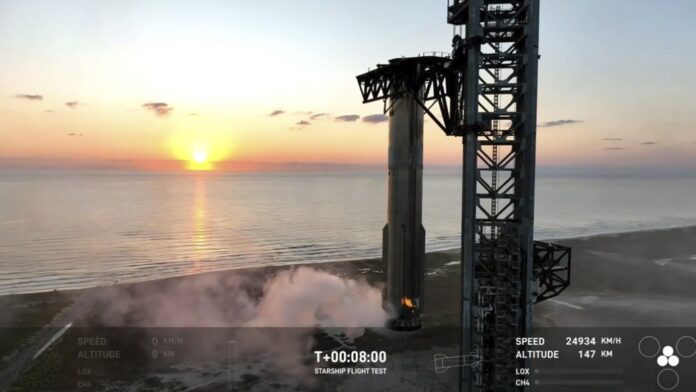
This image provided by SpaceX shows SpaceX’s mega Starship rocket upon its return during a test flight, Sunday, Oct. 13, 2024, over Boca Chica, Texas.
AP/SpaceX
hide caption
toggle caption
AP/SpaceX
SpaceX on Sunday successfully “caught” its “Super Heavy” booster on its first attempt during a flight test, a first for the company and its most powerful spacecraft.
Starship lifted off from its launch tower into clear morning skies from the Starbase facility in Boca Chica, Texas, at 7:25 a.m. CT with all 33 of its Raptor engines firing flawlessly.
Seven minutes into the flight test and after separating from the Starship’s vehicle, the rocket booster was successfully caught for the first time ever in “Mechazilla,” a mechanism with chopstick-like arms on a tower on the launch pad. SpaceX staff cheered as the booster descended onto Mechazilla with 13 engines burning before ultimately being caught with three engines burning.
“The tower has caught the rocket!!,” SpaceX Founder Elon Musk posted on X with a clip of the moment the booster was caught.
Starship, which was crewless, coasted in space for nearly 45 minutes before splashing down in the Indian Ocean at 9:30 a.m. CT an hour and five minutes into the flight test. A flash from the spacecraft once it landed in the ocean was seen on SpaceX’s livestream of the vehicle’s reentry.
“Ship landed precisely on target! Second of two objectives achieved,” Musk said in another post on X with a clip of Starship landing in the ocean.
The success of the flight is a significant step for the company as it aims to one day use Starship to carry astronauts and supplies into Earth’s orbit, as well as onto the Moon and planets such as Mars. The largest rocket ever built, Starship is 397 feet tall, including the rocket booster, which SpaceX says is “fully reusable.”
Significant improvements have been made to the spacecraft since its first launch in April 2023, when the rocket exploded shortly after liftoff. Starship’s heatshield was reworked, SpaceX says: Its thermal protection system was replaced with newer tiles and included additional protections between the flaps and a backup layer.
SpaceX was not trying to recover the spacecraft and was attempting to demonstrate that it could bring Starship down to its target under control.
Sunday’s launch also comes amid a backdrop of concern about the environmental impact the flight tests are having on the areas around the launchpad.
NPR’s Geoff Brumfiel contributed to this report.




